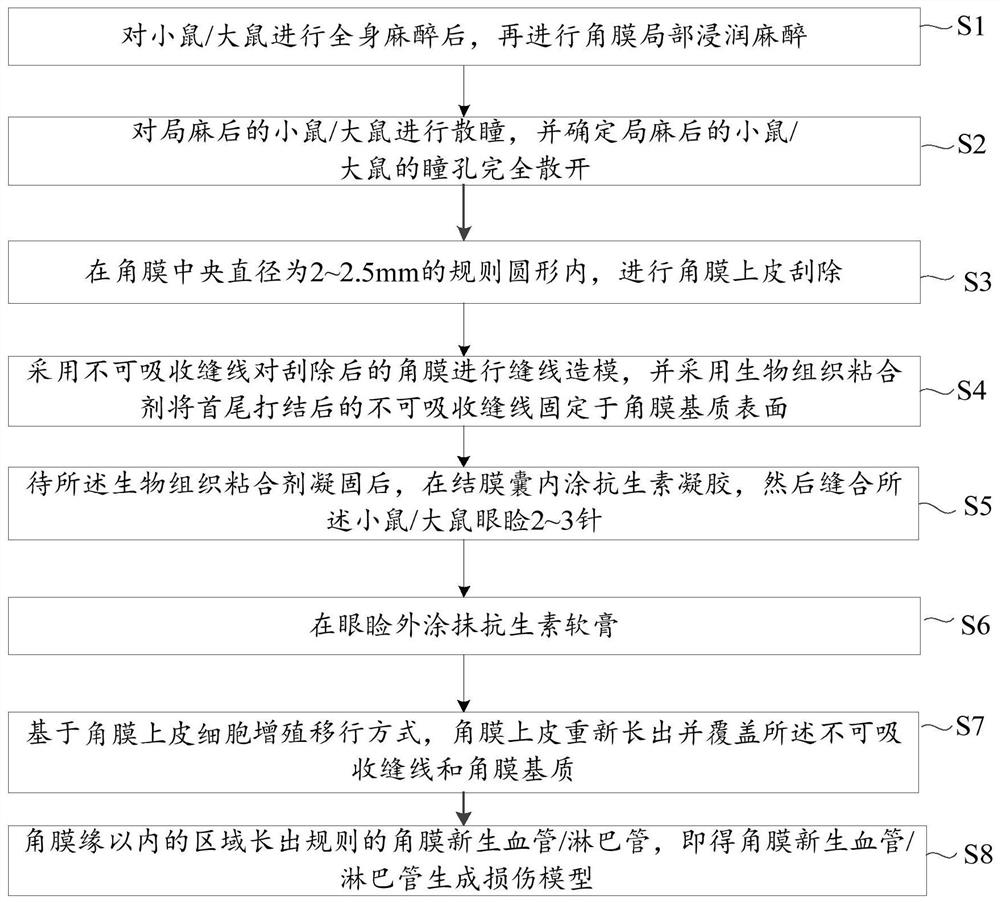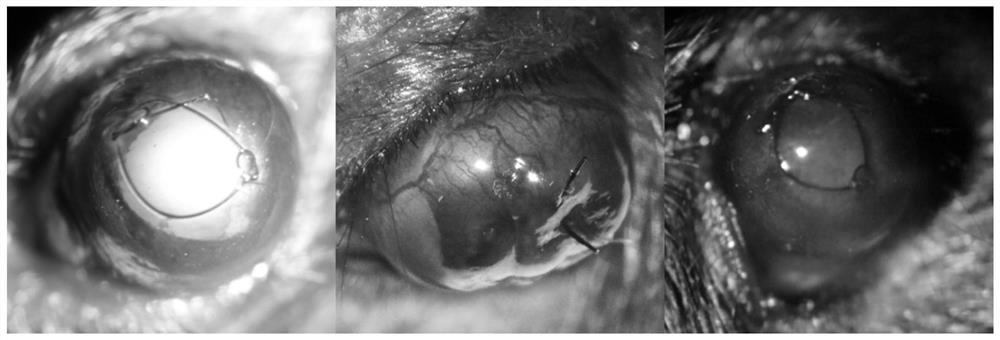Corneal neovascularization/lymphatic vessel generation injury model and construction method and application thereof
A corneal neovascularization and damage model technology, which can be used in pharmaceutical formulations, veterinary surgery, veterinary instruments, etc., to solve problems such as increased, unfavorable corneal neovascularization or corneal lymphatic vessels, and scarring.
- Summary
- Abstract
- Description
- Claims
- Application Information
AI Technical Summary
Problems solved by technology
Method used
Image
Examples
Embodiment 1
[0088] Animals required: C57 adult mice
[0089] Equipment: Stereo microscope, microsurgical instruments, corneal epithelial mechanical scraper, obcaine anesthetic, biological tissue adhesive, 10-0 non-absorbable suture
[0090] Operating procedures:
[0091] In step 1 (S1), after general anesthesia is performed on C57 adult mice, local corneal infiltration anesthesia is performed.
[0092] During specific implementation, a mixed solution of 3.3% tribromoethanol and tert-amyl alcohol (1 g: 1 ml) was prepared, and intraperitoneal anesthesia was performed at 0.024 ml / g body weight. C57 adult mice can be injected intraperitoneally with a 1ml syringe with a No. 4 needle. During intraperitoneal injection, hold the syringe in the right hand, grasp the tail of the C57 adult mouse with the little finger and ring finger of the left hand, and grasp the neck of the C57 adult mouse with the other three fingers, so that the head of the C57 adult mouse is down. In this way, the organs in...
Embodiment 2
[0117] The construction method of this embodiment is similar to the construction method of embodiment 1, and the differences are as follows:
[0118] In step 1, after 3 min of intraperitoneal injection of anesthesia, complete animal general anesthesia.
[0119] In step 2, the pupil dilation time is 3 minutes, and after 3 minutes, the pupils can be completely dilated under the light under a stereomicroscope.
[0120]In step 3, when the cornea is scraped mechanically, it is scraped to the superficial stromal layer; the specific mechanical scraping operation is: use alcohol to assist and use a 2mm marker ring to place an indentation in the center of the cornea, inject 30ul of 20% ethanol into the ring, and after 30s Absorb the remaining ethanol with a dry blood-sucking sponge, immediately rinse the corneal epithelium with balanced solution or saline, and mechanically scrape off the regular circular corneal epithelium with a diameter of 2.5 mm to expose the superficial stroma.
...
Embodiment 3
[0127] The construction method of this embodiment is similar to the construction method of embodiment 1, and the differences are as follows:
[0128] SD adult rats were selected in this embodiment, and a rat corneal neovascularization / lymphangiogenesis injury model was constructed.
[0129] The rat corneal neovascularization / lymphangiogenesis injury model constructed in this example, its new blood vessel map under the slit lamp 14 days after the suture operation, the lymphatic vessel (LYVE1) immunofluorescence staining map and the model 14 days after the suture operation The diagrams in the damage process are the same as those shown in Example 1, and will not be repeated in this example.
PUM
 Login to View More
Login to View More Abstract
Description
Claims
Application Information
 Login to View More
Login to View More - R&D
- Intellectual Property
- Life Sciences
- Materials
- Tech Scout
- Unparalleled Data Quality
- Higher Quality Content
- 60% Fewer Hallucinations
Browse by: Latest US Patents, China's latest patents, Technical Efficacy Thesaurus, Application Domain, Technology Topic, Popular Technical Reports.
© 2025 PatSnap. All rights reserved.Legal|Privacy policy|Modern Slavery Act Transparency Statement|Sitemap|About US| Contact US: help@patsnap.com



